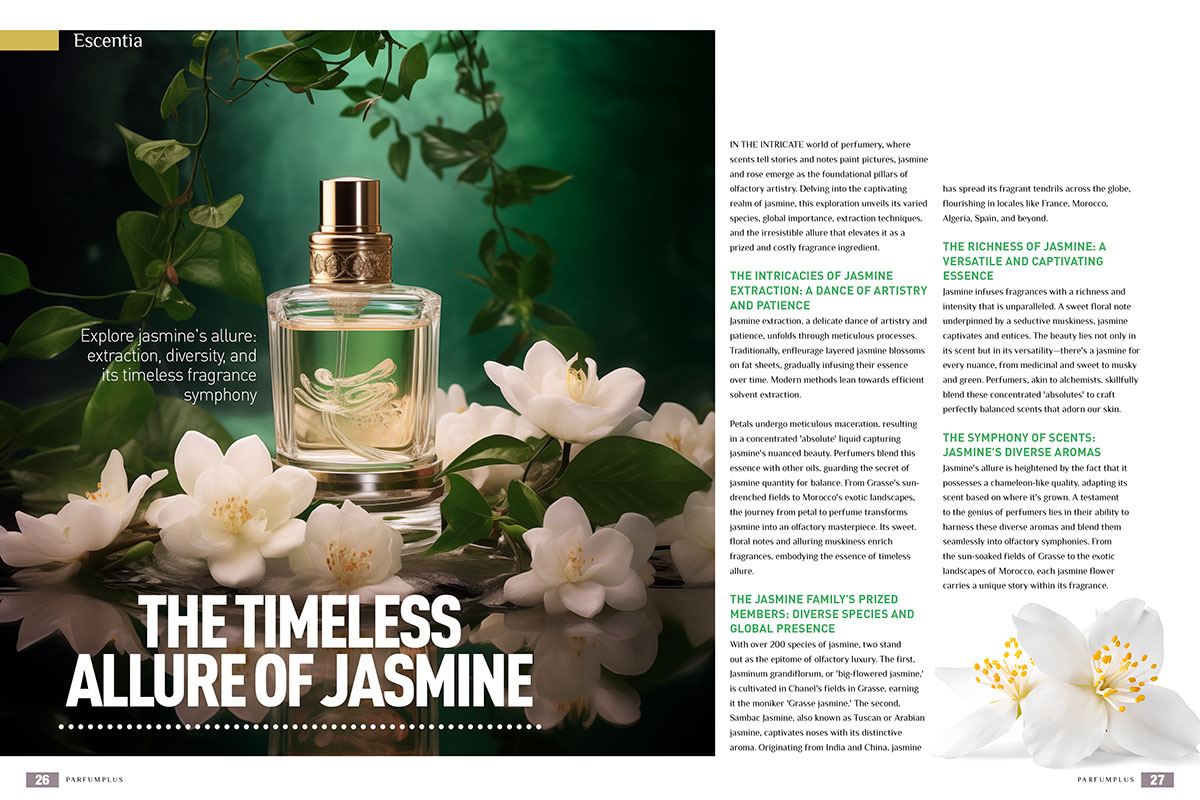Read this post in
 Arabic
Arabic
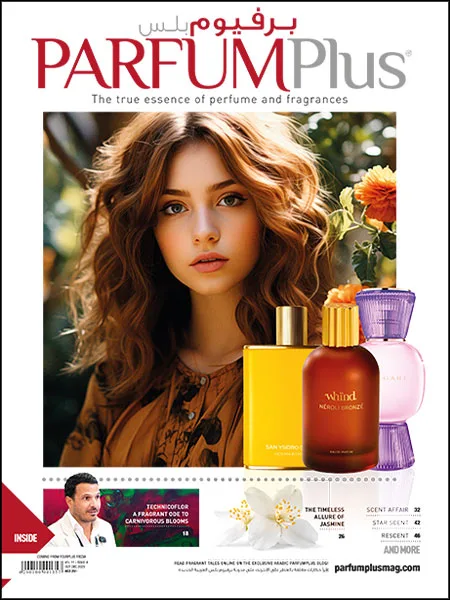
The Timeless Allure Of Jasmine
Explore jasmine's allure: extraction, diversity, and its timeless fragrance symphony
In the intricate world of perfumery, where scents tell stories and notes paint pictures, jasmine and rose emerge as the foundational pillars of olfactory artistry. Delving into the captivating realm of jasmine, this exploration unveils its varied species, global importance, extraction techniques, and the irresistible allure that elevates it as a prized and costly fragrance ingredient.
The Intricacies of Jasmine Extraction: A Dance of Artistry and Patience
Jasmine extraction, a delicate dance of artistry and patience, unfolds through meticulous processes. Traditionally, enfleurage layered jasmine blossoms on fat sheets, gradually infusing their essence over time. Modern methods lean towards efficient solvent extraction.
Petals undergo meticulous maceration, resulting in a concentrated 'absolute' liquid capturing jasmine's nuanced beauty. Perfumers blend this essence with other oils, guarding the secret of jasmine quantity for balance. From Grasse's sun-drenched fields to Morocco's exotic landscapes, the journey from petal to perfume transforms jasmine into an olfactory masterpiece. Its sweet, floral notes and alluring muskiness enrich fragrances, embodying the essence of timeless allure.
The Jasmine Family's Prized Members: Diverse Species and Global Presence
With over 200 species of jasmine, two stand out as the epitome of olfactory luxury. The first, Jasminum grandiflorum, or 'big-flowered jasmine,' is cultivated in Chanel's fields in Grasse, earning it the moniker 'Grasse jasmine.' The second, Sambac Jasmine, also known as Tuscan or Arabian jasmine, captivates noses with its distinctive aroma. Originating from India and China, jasmine has spread its fragrant tendrils across the globe, flourishing in locales like France, Morocco,
Algeria, Spain, and beyond.
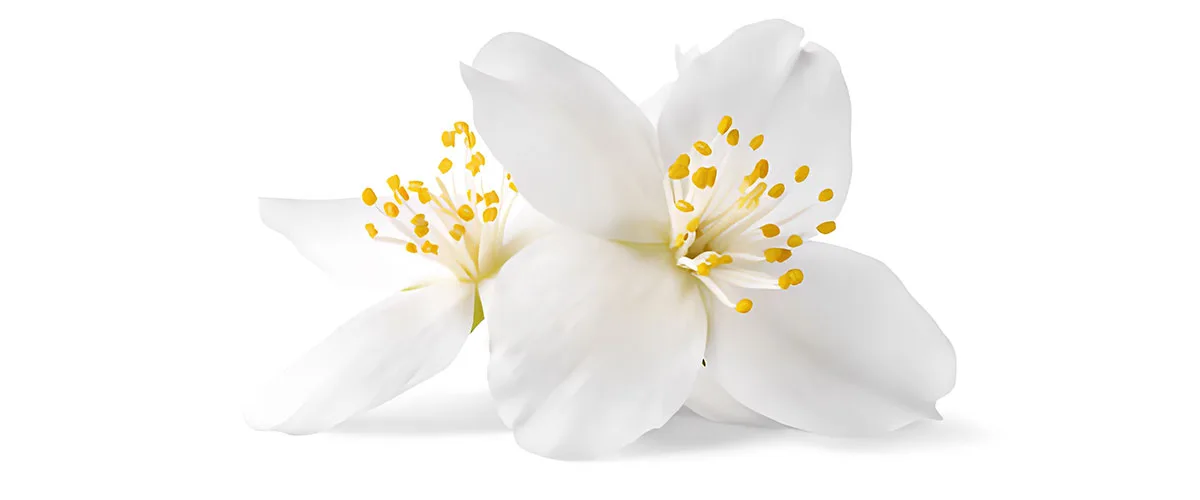
The Richness of Jasmine: A Versatile and Captivating Essence
Jasmine infuses fragrances with a richness and intensity that is unparalleled. A sweet floral note underpinned by a seductive muskiness, jasmine captivates and entices. The beauty lies not only in its scent but in its versatility—there's a jasmine for every nuance, from medicinal and sweet to musky and green. Perfumers, akin to alchemists, skillfully blend these concentrated 'absolutes' to craft perfectly balanced scents that adorn our skin.
The Symphony of Scents: Jasmine's Diverse Aromas
Jasmine's allure is heightened by the fact that it possesses a chameleon-like quality, adapting its scent based on where it's grown. A testament to the genius of perfumers lies in their ability to harness these diverse aromas and blend them seamlessly into olfactory symphonies. From the sun-soaked fields of Grasse to the exotic landscapes of Morocco, each jasmine flower carries a unique story within its fragrance.
From Enfleurage to Solvent Extraction: Preserving Magic in Transition
Once extracted through the romantic process of enfleurage—pressing flowers into layers of fat, allowing the scent to migrate to the fat—jasmine's essence now undergoes a less poetic solvent extraction. Despite the shift in methods, the magic remains undiminished. It takes an astonishing number of blossoms—around 8,000 hand-picked blooms—to produce a mere millilitre of jasmine 'absolute'. This laborious process contributes to its reputation as one of the costliest ingredients in perfumery.
Jasmine's Synthetic Twin: Balancing Cost and Authenticity
Given the exorbitant cost of natural jasmine, synthetic alternatives have become prevalent in the industry. While these recreations capture the essence of jasmine, aficionados argue that they lack the soul and depth of the real thing. This divide fuels the pride of fragrance houses that boast of 'real' jasmine in their formulations, emphasising the authenticity and tradition behind their creations.
Jasmine's Moniker: La Fleur
In the perfume world, jasmine is often referred to as 'La Fleur' or 'The Flower.' This simple yet profound name encapsulates the essence of jasmine's significance. No other note, save for the esteemed rose, holds as much importance for 'noses,' the connoisseurs and creators of the fragrances we cherish. The journey from bloom to bottle is a meticulous art, and jasmine is the crown jewel in this fragrant tapestry.
Jasmine and Rose: Complementary Forces in the Fragrance Ballet
In the grand ballet of perfumery, jasmine and rose perform a mesmerising duet. While jasmine lends its intoxicating richness, rose adds a delicate, romantic nuance. Together, they create symphonies of scent that linger in memory and on the skin. Perfumers often play with the delicate balance between these floral powerhouses, creating timeless classics that stand the test of time.
In the ever-changing landscape of perfumery trends, jasmine stands as a timeless icon. Whether Grasse's prized bloom or the exotic Sambac variety, the journey from petal to perfume embodies craftsmanship and tradition. Amid fleeting trends, jasmine's enduring fragrance weaves an aromatic magic, creating a timeless presence in the world of perfumery.
Discover timeless perfumes that showcase jasmine as their central allure
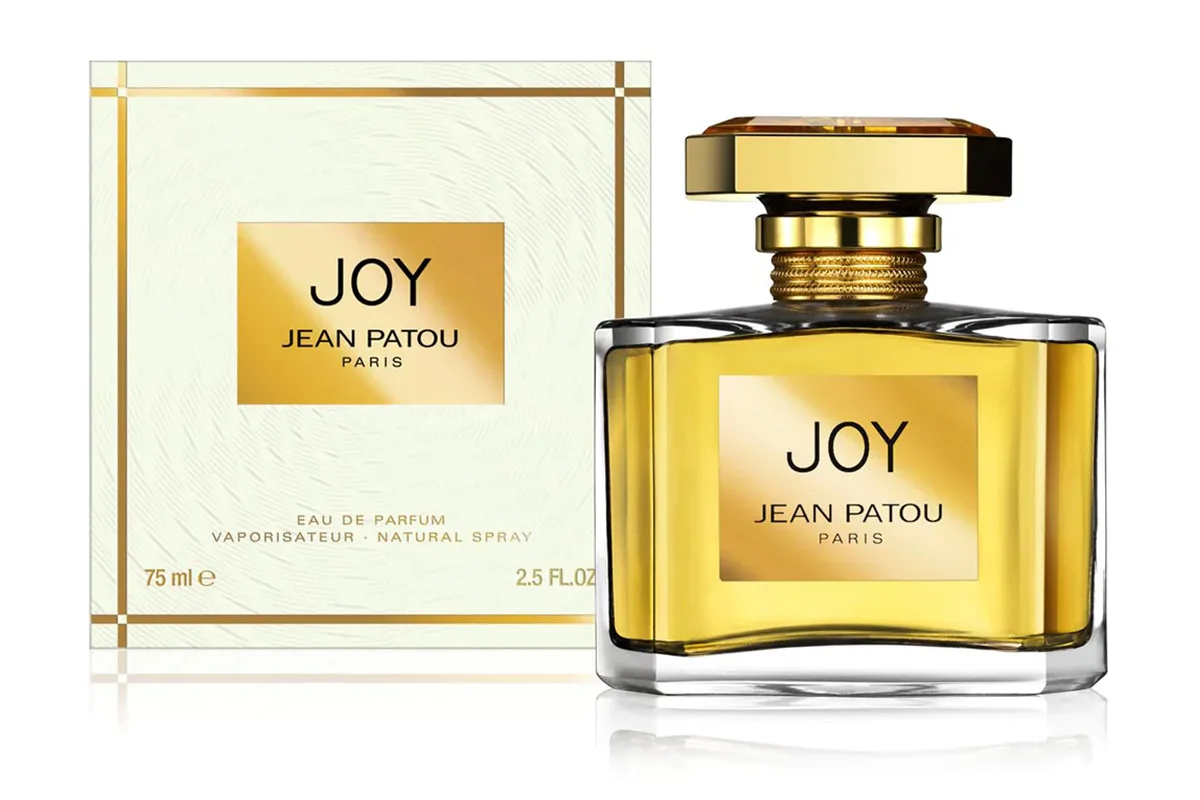
Joy
by Jean Patou
Crafted in 1930, Jean Patou Joy stands as the epitome of classic jasmine elegance. Adorned with opulence, each ounce hosts 10,600 jasmine flowers and 28 dozen May roses, encapsulated in a bottle inspired by Ancient Greek divine proportion.
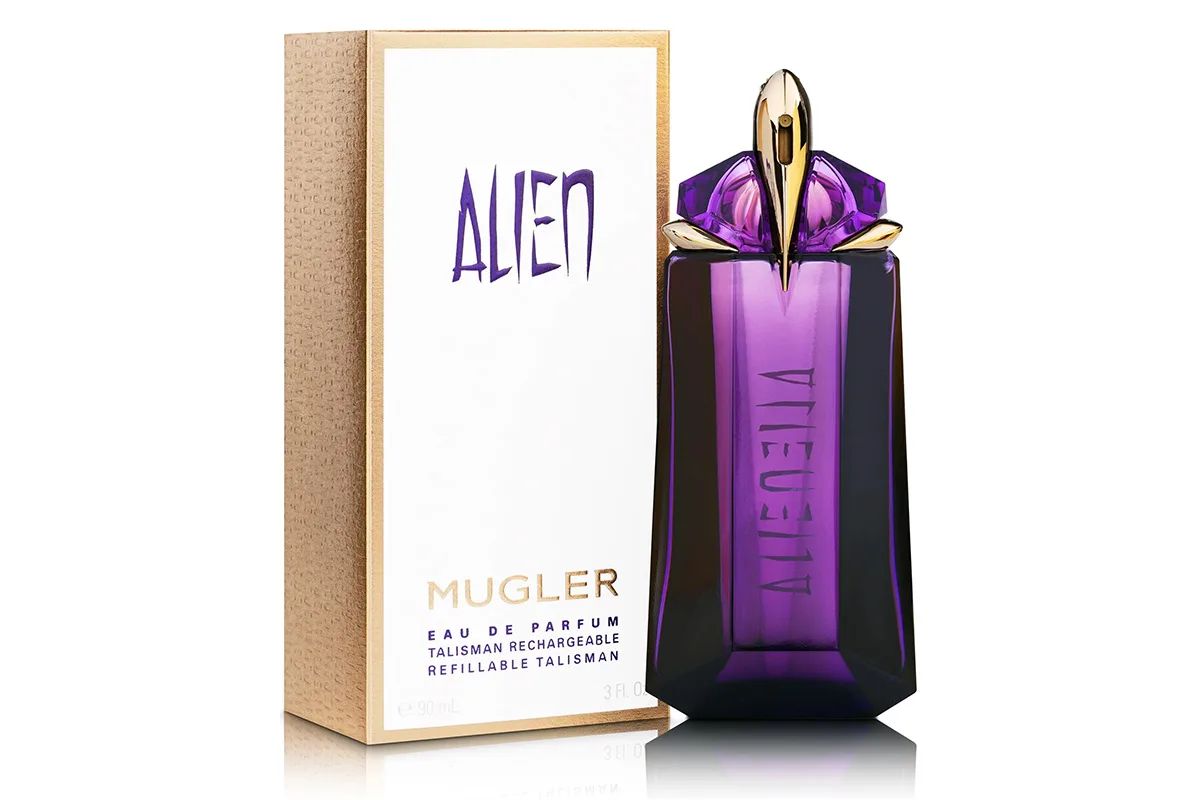
Alien
by Mugler
For a modern take, Mugler's Alien perfume enthrals with celestial Jasmine Sambac from India. Perfumers Ropion and Bruyere weave a symphony, harmonising the delicate flower's warmth, embodying the sun's radiance. Alien's magnetic allure, a dance of jasmine, Cashmeran wood, and white amber, reveals a mesmerising feminine power.
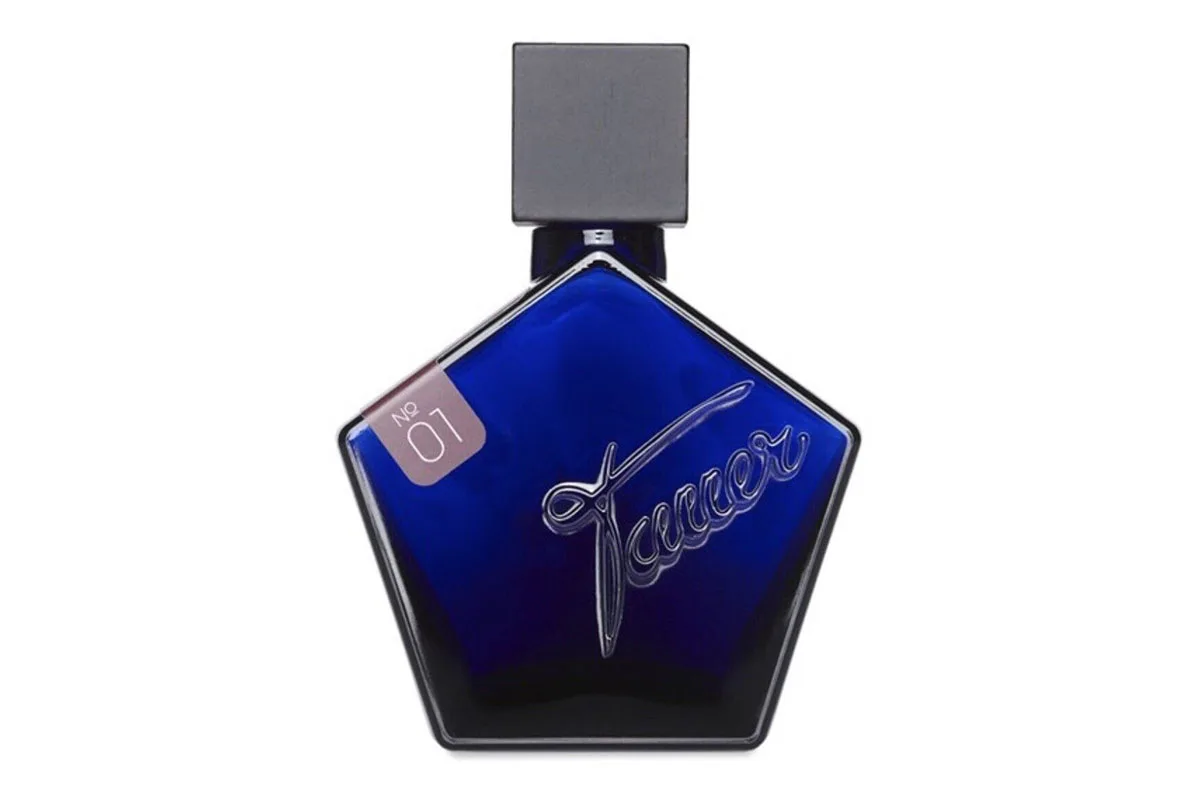
Le Maroc Pour Elle
by Andy Tauer
In the niche world, Andy Tauer's Le Maroc Pour Elle unfolds an oriental fantasy, infused with Maghreb roses and Moroccan jasmine. Capturing the allure of a Moroccan sunrise and the seductive evening aroma of jasmine, this fragrant masterpiece, adorned with citrus and woody undertones, paints a sensual olfactory portrait of the Maghreb.
Read this post in
 Arabic
Arabic



